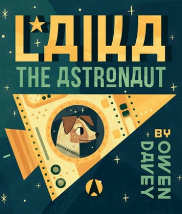Laika the Astronaut by Owen Davey

Allen & Unwin, 2014. ISBN 9781743318935.
(Age: K-3) On November 3, 1957, after the success of Sputnik 1 which
put the Russians at the head of the space race and sparked the
development of science and technology in a way not previously
experienced, Sputnik 2 was launched to coincide with the 40th
anniversary of the Bolshevik Revolution. Aboard the craft was a
stray dog from the streets of Moscow who had been named Laika
(meaning Barker in English) whose sole purpose was to test the
viability of putting a living creature into space, test its ability
to survive weightlessness and thus pave the way for human
spaceflight.
Laika the Astronaut is a gentle retelling of the start of
Laika's adventure. From being alone in the streets of Moscow,
wishing on the stars for a family to love her, to her rigorous
training and testing regime and finally blast off, it introduces the
reader to this embedded-in-history creature. But even though
everyone in the world knew Laika's name as she circled the Earth,
she felt more alone than ever.
Official records show that Laika actually died very soon into the
flight from heat exhaustion, but Owen Davey has provided a much
happier ending - one that he chooses to believe and one that will
appeal to the reader and perhaps spark some speculation about her
new life might have been like. 'This poor little pooch plucked at my
heartstrings, and I wanted to explore this idea of a soul living on
through your imagination.'
Davey has rejected the claims that the ending is sugar-coated and
that is has avoided the issue of death. He says, 'My intention was
to put a positive spin on how we remember our loved ones when
they're gone. The main theme of the book is about finding love and
finding a family, but the deeper undercurrent revolves around the
way we deal with loss.' You can read more of the background story here
and with this knowledge in mind it might also be appropriate to
begin introducing students to the notion of authors doing more than
just telling a story to entertain, that many of the stories they
enjoy have a deeper, more subtle meaning than appears on the surface
and both the writer and reader are the richer for exploring it. In
this case, the starting point could be questioning why Davey chose
to change history in this way.
With its stylised illustrations in very muted colours which reach
back to the style of the times, this is a wonderful picture book
that could be used to introduce younger children to the history of
space flight but which also has a place with older children who
might be considering the ethical treatment of animals - scientists
involved in the mission have even stated that they don't think they
learned enough from the mission to justify what they did - or even
the ramifications of the Mars 1
project which proposes to have humans inhabiting Mars by 2023 and
for which 28 Australians are still in the running. Does the means
ever justify the ends?
Barbara Braxton